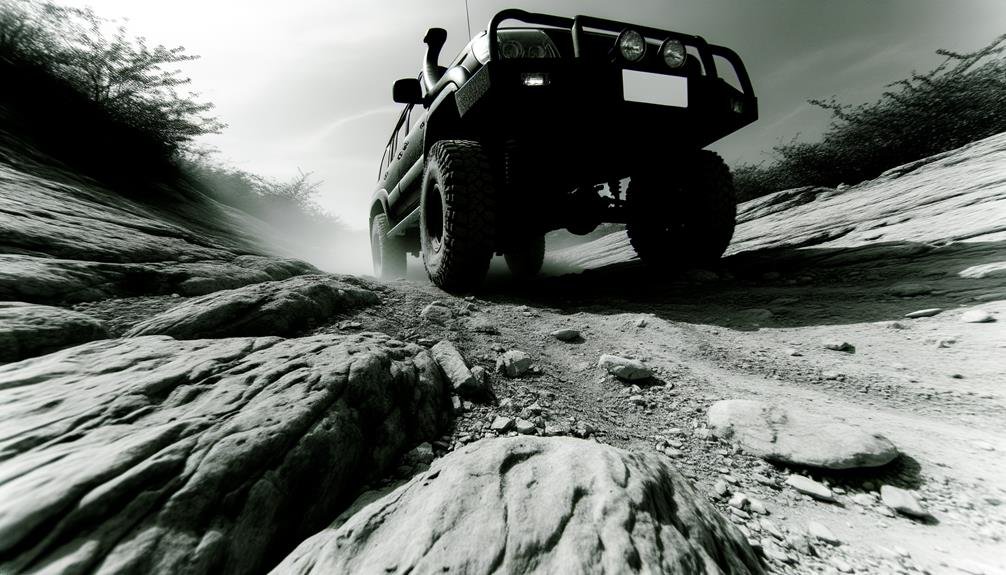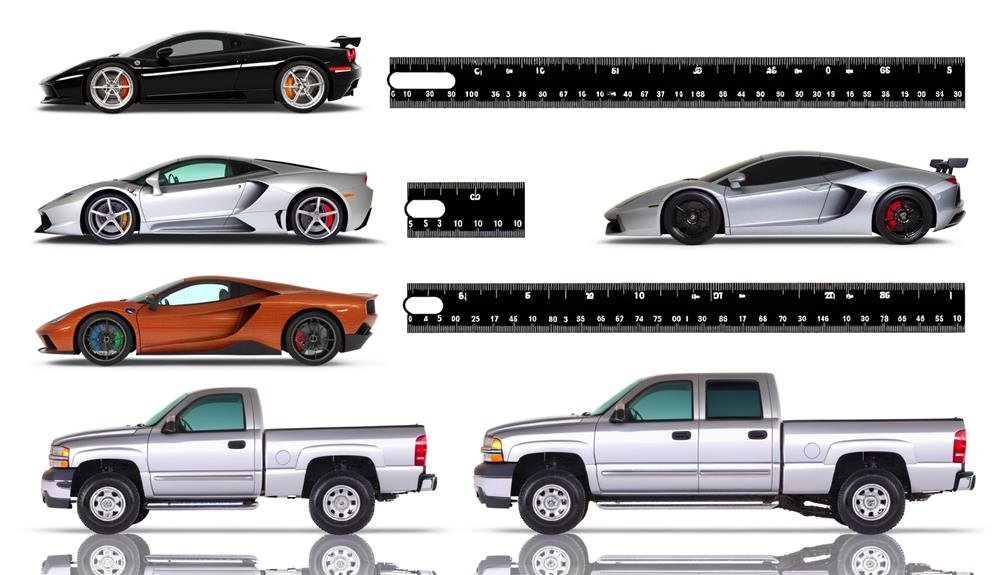Charles Miller is a veteran bike enthusiast with over 12 years of experience dealing with bikes as a mechanic. Despite immense love and expertise for...
Navigating the complexities of ground clearance in vehicles can be challenging, yet it is a critical factor to consider for those who frequently traverse off-road terrains. Ground clearance, the measure of space from the base of your tire to the lowest point of your vehicle's undercarriage, plays a pivotal role in determining the type of terrains your vehicle can handle.
From simple dirt roads to rugged rocky terrains, the required ground clearance can vary significantly, often necessitating modifications to your vehicle. Understanding this concept, its implications, and how it can be adjusted to suit your needs is, therefore, essential for any off-road enthusiast.
As we delve deeper into this topic, we will also explore how to accurately measure your vehicle's ground clearance and tips for modifying it, should the need arise.
Key Takeaways
- Ground clearance is an important factor in determining an off-road vehicle's capabilities and performance.
- Adequate ground clearance ensures safe navigation through various terrains and protects the vehicle's undercarriage.
- Ground clearance directly impacts the vehicle's maneuverability, approach, departure, and break-over angles.
- The amount of ground clearance needed depends on the terrain type, vehicle design, intended use, and other factors such as tire type and engine power.
Understanding Ground Clearance
Ground clearance, a critical parameter in the automotive world, refers to the minimum distance between the vehicle's lowermost part and the surface of the terrain, playing a significant role in handling challenging off-road conditions and preventing potential damage to the undercarriage. Depending on the terrain, vehicles ground clearance requirements can range from 6.6 inches for gravel, mud, and sand tracks, up to 10.8 inches for tackling rock crawling.
To fully appreciate the concept of ground clearance, we must also understand clearance angles such as the approach, departure, and breakover angles. These angles, in conjunction with high ground clearance, provide a comprehensive picture of a vehicle's off-road capabilities.
Achieving a high ground clearance of eight to ten inches can be accomplished through a variety of methods, including purchasing larger tires, installing coil spring spacers, or employing a suspension lift kit. However, it's crucial to remember that ground clearance is merely one out of the 54 aspects of an off-road vehicle's performance. Other components such as all-terrain tires, powerful engines, adjustable suspension, and heavy-duty chassis also play a pivotal role.
Understanding the clearance you need is, therefore, a complex, multi-layered analysis.
Importance of Adequate Clearance
Adequate ground clearance holds paramount importance in ensuring the safe navigation of a vehicle through various off-road terrains. It not only aids in protecting the vehicle's undercarriage from potential damage but also significantly influences the vehicle's handling, performance, and practicality.
Therefore, understanding the impact of ground clearance on vehicle performance is essential, as different terrains require specific ground clearance levels for optimal safety and operation.
Understanding Ground Clearance
Navigating through hazardous off-road conditions without inflicting damage to the undercarriage necessitates a vehicle with sufficient ground clearance. Understanding ground clearance is essential as it is the lowest point between the vehicles underbelly and the ground. For off-roading activities, it's crucial to have ample inches of clearance.
| Terrain Type | Minimum Clearance (inches) | Recommended Vehicles |
|---|---|---|
| Rock | 8.7 | Jeep Wrangler |
| Sand | 7.9 | Toyota Land Cruiser |
| Snow | 8.3 | Subaru Outback |
| Mud | 9.1 | Land Rover Discovery |
These numbers are just guidelines. Every individual's needs are unique, and the key to belonging within the off-roading community is understanding the importance of adequate clearance.
Impact on Vehicle Performance
While understanding the significance of ground clearance in off-roading scenarios is vital, it is equally crucial to explore its impact on overall vehicle performance, particularly in terms of maneuverability and damage prevention.
Correct ground clearance enhances the off-roading experience by allowing vehicles to smoothly negotiate obstacles, mitigating potential damage to the undercarriage. It is intrinsically linked to vital performance parameters such as approach, departure, and break-over angles, thus directly influencing the vehicle's off-road practicality.
Ignoring ground clearance can result in severe damage, affecting both the vehicle's integrity and the owner's finances. Therefore, for those seeking off-road adventures, choosing the right vehicle with an appropriate ground clearance is key to a superior and safe off-roading experience.
Ground Clearance for Off-Roading

Understanding the role of ground clearance in off-roading is essential, as it significantly influences a vehicle's ability to traverse various terrains, including rock, sand, snow, and mud, without incurring damage. Ground clearance for off-roading is the distance between the vehicle's undercarriage and the rough terrain. It is crucial to protect the car's components nestled in the wheel wells and to enhance breakover angles.
Moreover, the amount of ground clearance needed depends on the type of terrain. For instance, rockier terrains require more clearance than sandy ones. Here's a table summarizing the different ground clearance requirements:
| Terrain Type | Ground Clearance (approx) | Vehicle Modification |
|---|---|---|
| Rock | High | Suspension Lift |
| Sand | Medium | Off-road tires |
| Snow/Mud | Low to Medium | Wheel Well Protection |
To increase ground clearance, one can opt for larger off-road tires, coil spring spacers, or a suspension lift kit. However, remember that while ground clearance is crucial, other factors like tire type and engine power also play a significant role in off-roading performance. So, always consider the question, 'how much ground clearance do I need?' in relation to the specific off-roading conditions you anticipate.
Influencing Factors on Clearance Need
Several key factors influence the need for ground clearance in off-road vehicles. These factors include the type of terrain, the vehicle's design, and the intended use of the vehicle.
The type of terrain significantly impacts the clearance requirement. For instance, rock crawling demands a higher clearance to avoid damage to the vehicle's lowest part.
The vehicle's design, specifically the wheelbase and tires, also plays a crucial role in determining the necessary ground clearance. Larger tires can increase clearance, improving the approach and departure angles for overcoming obstacles.
Furthermore, the vehicle's intended use is a determinant factor. For recreational off-roading, standard clearance might suffice. However, for more extreme activities, a lift kit might be necessary to raise the vehicle's height and provide additional clearance.
In addition to these factors, the approach angle and departure angle are significant in determining the necessary ground clearance. The approach angle refers to the maximum angle a vehicle can climb without hitting the front end, while the departure angle is the steepest angle a vehicle can descend without scraping the rear end. Both angles are influenced by the ground clearance and the vehicle's design.
Therefore, understanding these influencing factors is crucial for optimal off-road performance.
Modifying Vehicle Ground Clearance

Given the significance of ground clearance in off-roading performance, as influenced by factors like terrain and vehicle design, it is essential to explore the various methods of modifying this crucial aspect to enhance a vehicle's capabilities. Modifying vehicle ground clearance can be accomplished through several techniques, such as the installation of larger tires and body lift kits.
Larger tires not only increase the distance from the ground to the vehicle's undercarriage but also provide a better approach angle, allowing the vehicle to climb steeper inclines without scraping the front. A body lift, on the other hand, raises the body of the vehicle from the frame, enhancing clearance while maintaining the center of gravity. This is especially beneficial for vehicles like the Toyota Tacoma, improving its off-road performance while preserving its stability.
Another modification method is the use of coil spring spacers or suspension lift kits. These options increase the Jeep hardtop's ground clearance, promoting better handling of different terrains and reducing the risk of damage from rocks or ruts. However, it's worth noting that modifications should always maintain a balance between increased ground clearance and overall vehicle stability.
Tips for Measuring Ground Clearance
In the realm of vehicular performance, accurately measuring ground clearance necessitates a meticulous approach, beginning with the identification of the lowest point on the vehicle's undercarriage. This task cannot be completed without a clear understanding of the vehicle's structure and geometry, including the angle of the front bumper and the circumference of all-terrain tires, if installed.
Here are four tips for measuring ground clearance:
- Use a reliable measuring tool, such as a measuring tape or ruler, to measure the distance from the identified lowest point to the ground.
- Always conduct measurements on a level surface with the tires inflated to their correct pressure. This will ensure precision and consistency in the readings.
- To get an accurate average ground clearance, take measurements from multiple points around the vehicle. This includes the front, middle, and rear sections.
- Record all measurements and compare them to manufacturer's specifications or other reference sources. This will allow you to assess whether the vehicle's ground clearance is within an acceptable range.
Frequently Asked Questions
What Is a Good Amount of Ground Clearance?
The ideal clearance depends on terrain impact and vehicle variations. Clearance importance is paramount for off-roading, with clearance measurements of 6-8 inches typically adequate. However, clearance considerations must account for potential clearance consequences on vehicle performance.
Is 10 Inches of Ground Clearance Enough?
While 10 inches of ground clearance offers significant off-roading capabilities, it may compromise on vehicle stability, fuel efficiency and ride comfort. Higher clearance also potentially increases maintenance costs due to enhanced susceptibility to undercarriage damage.
Is 4 Inches of Ground Clearance Enough?
Four inches of ground clearance may be insufficient for off-roading, posing safety implications and impacting performance. Clearance benefits vary by vehicle type and terrain considerations, thus higher clearance is often necessary to navigate challenging conditions effectively.
How Much Ground Clearance Is Safe?
The optimal ground clearance depends on terrain and vehicle use. Clearance safety is paramount; Clearance measurements should consider clearance factors such as obstacles and road conditions. Always prioritize safety concerns in clearance considerations.
Conclusion
In conclusion, ground clearance is a pivotal determinant when off-roading, with the required amount hinging on the terrain complexity. Factors such as vehicle type, tire size, and suspension can impact clearance needs.
Modifications may be requisite to augment ground clearance. Precision in measuring ground clearance is paramount to ensure optimal performance and safety.
Thus, the juxtaposition of low clearance risks and high clearance benefits evokes a profound understanding of its significance in successful off-roading adventures.

Charles Miller is a veteran bike enthusiast with over 12 years of experience dealing with bikes as a mechanic. Despite immense love and expertise for his Tacoma, he rides his Trek Ebike more. Anytime you meet him, you’ll either hear him talking about Bikes, or writing about all things bikes and cars on this blog.
More Posts


